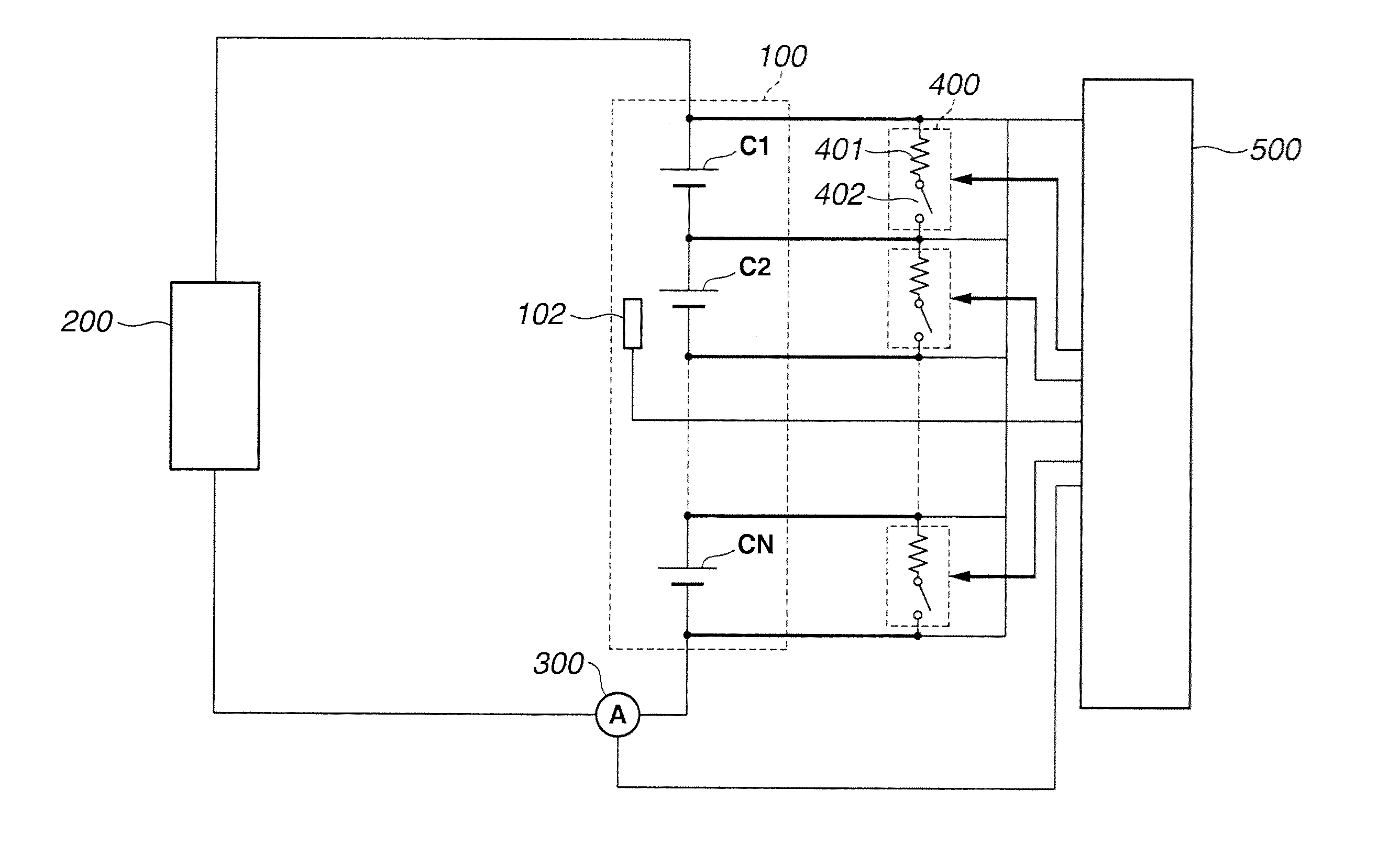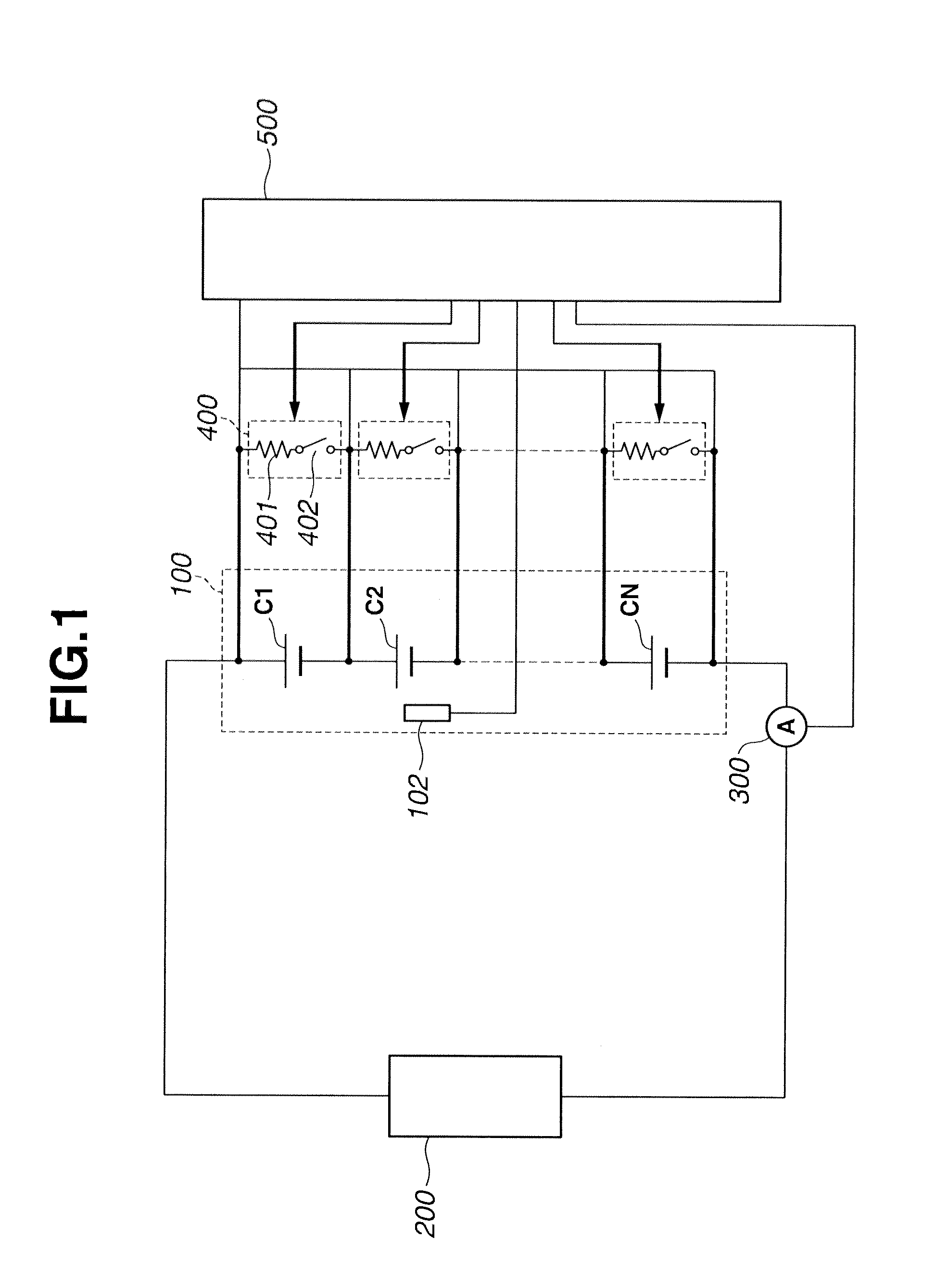Device for controlling assembled battery
a technology for assembled batteries and battery cells, applied in the direction of electrochemical generators, instruments, transportation and packaging, etc., can solve the problems of long time needed and the inability to predict the time when the assembled battery becomes abnormal
- Summary
- Abstract
- Description
- Claims
- Application Information
AI Technical Summary
Benefits of technology
Problems solved by technology
Method used
Image
Examples
first embodiment
[0025]FIG. 1 is the system diagram illustrating an assembled battery system of the embodiment. The assembled battery system of the embodiment is hereunder exemplified in a battery for use in an automotive vehicle such as a hybrid vehicle, an electric vehicle or the like.
[0026]As shown in FIG. 1, the assembled battery system of the embodiment is comprised of an assembled battery 100 provided with a plurality of single batteries C1, C2, . . . , CN, connected in series with each other, a load 200 electrically connected to both ends of the assembled battery 100, capacity adjustment circuits 400 for adjusting a capacity of the assembled battery 100, and a battery controller 500 for controlling the whole assembled battery system.
[0027]Assembled battery 10 is constructed by connecting single batteries C1, C2, . . . , CN, whose number N is an integer, in series. An alkaline storage battery such as a nickel-hydrogen battery cell or an organic electrolyte secondary battery such as a lithium-i...
second embodiment
[0074]Next, the second embodiment of the invention is hereunder described.
[0075]The second embodiment is similar to the first embodiment except that, in the assembled battery system shown in FIGS. 1-2, abnormality-time prediction processing is executed by a method described below.
[0076]The abnormality-time prediction processing of the second embodiment is hereinafter described.
[0077]FIGS. 8-9 are the flowchart illustrating the flow of the abnormality-time prediction processing of the second embodiment. The abnormality-time prediction processing, hereinafter described in detail, is initiated when turning on an ignition switch of the vehicle, on which the assembled battery system of the second embodiment is mounted, or when powering the vehicle's electrical systems by the charging-on system. The following processing is executed mainly by means of the prediction section 507 of the battery controller 500.
[0078]First, at step S101, in the same manner as the previously-discussed step S1 o...
third embodiment
[0098]Next, the third embodiment of the invention is hereunder described.
[0099]The third embodiment is similar to the first embodiment except that, in the assembled battery system shown in FIGS. 1-2, abnormality-time prediction processing is executed by a method described below.
[0100]The abnormality-time prediction processing of the third embodiment is hereinafter described.
[0101]FIG. 13 is the flowchart illustrating the flow of the abnormality-time prediction processing of the third embodiment. The abnormality-time prediction processing, hereinafter described in detail, is initiated when turning on an ignition switch of the vehicle, on which the assembled battery system of the third embodiment is mounted, or when powering the vehicle's electrical systems by the charging-on system. The following processing is executed mainly by means of the prediction section 507 of the battery controller 500.
[0102]First, at step S301, in the same manner as the previously-discussed step S1 of the fi...
PUM
 Login to View More
Login to View More Abstract
Description
Claims
Application Information
 Login to View More
Login to View More - R&D
- Intellectual Property
- Life Sciences
- Materials
- Tech Scout
- Unparalleled Data Quality
- Higher Quality Content
- 60% Fewer Hallucinations
Browse by: Latest US Patents, China's latest patents, Technical Efficacy Thesaurus, Application Domain, Technology Topic, Popular Technical Reports.
© 2025 PatSnap. All rights reserved.Legal|Privacy policy|Modern Slavery Act Transparency Statement|Sitemap|About US| Contact US: help@patsnap.com



